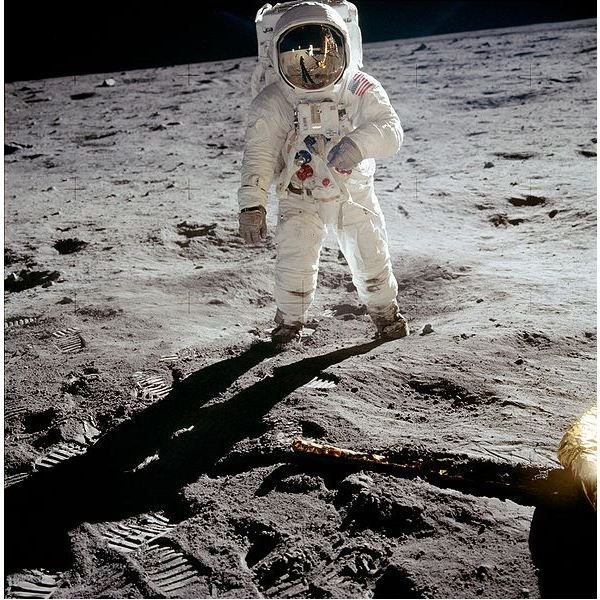Astronauts That Have Walked On The Moon - The Apollo Program, Neil Armstrong and the Lunar Rover
The Apollo Astronaut Program
NASA assigned a total of 41 individuals to take part in the Apollo missions. Over the course of the program, only 32 actually became part of the Apollo program, while the rest took part in the Skylab and Apollo-Soyuz programs. While 24 astronauts made it to the Moon’s orbit, there are only 12 astronauts that have walked on the Moon. The remainder stayed aboard the spacecraft.
During the nine missions to the lunar surface, three astronauts that have walked on the Moon were privileged to take part in two Apollo missions. However, they only got the chance to land on the surface once each. Since the Apollo missions ended in 1972, no person has had the opportunity to visit the satellite.
Apollo 11 - One Small Step
The first mission to successfully land humans on the Moon was Apollo 11. It launched on July 16, 1969, with three astronauts aboard. The lunar module with Neal Armstrong and Edwin “Buzz” Aldrin separated from the command module piloted by Michael Collins, on July 20. The lunar module landed on the surface. The next day, Armstrong was the first to exit the lander, giving his famed “one small step” statement. He was quickly joined by Buzz Aldrin, making the two men the first astronauts that have walked on the Moon.
Left: Buzz Aldrin on the lunar surface. (Image supplied by NASA; Public Domain; https://upload.wikimedia.org/wikipedia/commons/9/98/Aldrin_Apollo_11_original.jpg)
Apollo 12 - Surveyor 3 Recovery
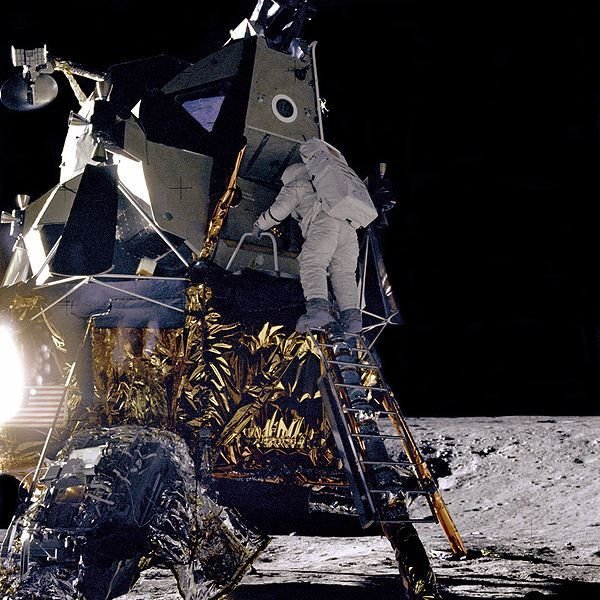
Apollo 12 became the second mission to land on the Moon. Commanded by Charles “Pete” Conrad, it launched a few months after the success of the previous mission on November 14, 1969. The lunar module landed in the Ocean of Storms, a large lunar plain believed to have been created by ancient volcanic activity. This time, the astronauts that landed were Alan Bean and Richard Gordon. The highlights of this mission were a precise splashdown and the collection of samples from the Surveyor 3 probe which landed near the same site in 1967.
Right: Alan Bean descends from the Intrepid. (Image supplied by NASA; Public Domain; https://upload.wikimedia.org/wikipedia/commons/7/78/Bean_Descends_Intrepid_-_GPN-2000-001317.jpg)
Apollo 14 - Golfing on the Moon
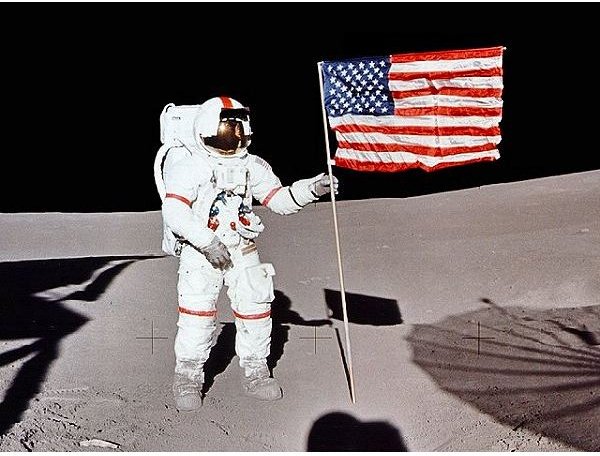
Following the near disaster of the Apollo 13 mission, Apollo 14 became the next mission to successfully land on the lunar surface. Launching on January 31, 1971, the team touched down on February 5 in the Fra Mauro crater. Alan Shepard and Edgar Mitchell became the next men who walked on the Moon, performing two separate moonwalks and collecting over 100 pounds of rock samples. Perhaps one of the most famous moments in lunar exploration occurred on this mission and had nothing to do with scientific research: Shepard was filmed hitting two golf balls with a club he brought from Earth.
Left: Alan Shepard on the Moon. (Image supplied by NASA; Public Domain; https://upload.wikimedia.org/wikipedia/commons/0/09/Apollo_14_Shepard.jpg)
Apollo 15 - Introducing the Lunar Rover
The fourth moon landing occurred on July 26, 1971, in what became the first long-duration mission from NASA. It was also the first occasion that the Lunar Rover was used aboard the surface. David Scott and James Irwin spent a total of 18.5 hours on the surface in the Mons Hanley region, exploring further from the lunar module than previous possible.

Right: Panaramic of Apollo 15. (Image supplied by NASA; Public Domain; https://upload.wikimedia.org/wikipedia/commons/c/ce/40_A15Sta8.jpg)
Apollo 16 - The Largest Moon Rock
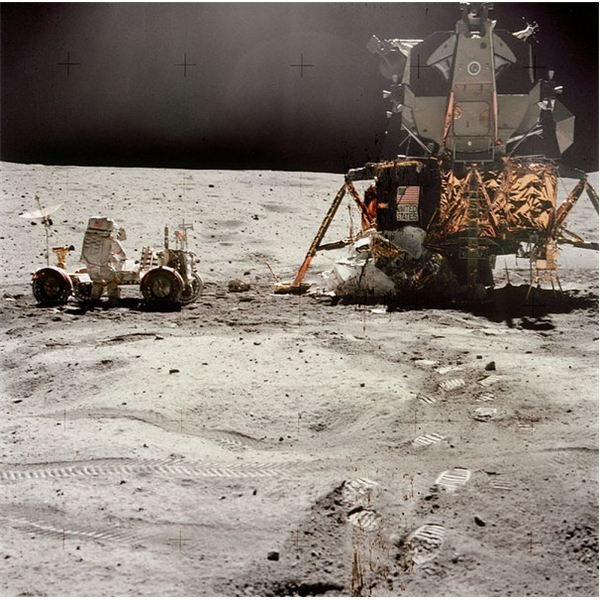
Launching on April 16, 1972, and lasting until April 27, Apollo 16 was another long-duration moon landing that featured three separate surface missions. Again with the aid of a Lunar Rover, John W. Young and Charles Duke explored the Descartes Highlands. Highlights of the mission included the successful landing following a malfunction in the command module and the procurement of a 25 pound piece of moon rock, the largest sample ever gathered.
Left: Young working on the Lunar Rover. (Image supplied by NASA; Public Domain; https://upload.wikimedia.org/wikipedia/commons/4/4c/Apollo_16_LM_Orion.jpg)
Apollo 17 - The Last Mission
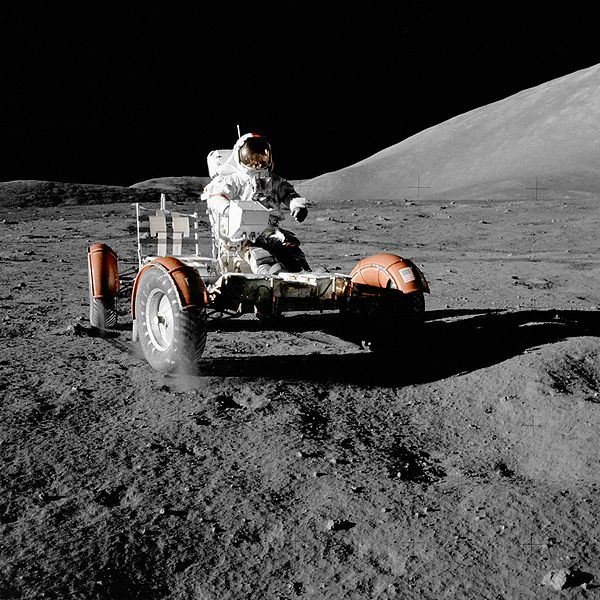
In the first night launch of human spaceflight, NASA launched the final moon landing mission on December 7, 1972. Apollo 17 was a mission of duration, setting records for the longest lunar vehicle usage and longest time in lunar orbit. Harrison Schmitt and Eugene Cernan became the last astronauts that have walked on the Moon. On December 14, Cernan reentered the lunar module, becoming the last person to leave the surface of the satellite.
Right: Apollo 17 Lunar Rover. (Image supplied by NASA; Public Domain; https://upload.wikimedia.org/wikipedia/commons/4/4d/NASA_Apollo_17_Lunar_Roving_Vehicle.jpg)
Resources
Apollo Program (https://www.thespaceplace.com/history/apollo2.html)
NASA’s Apollo Program (https://nssdc.gsfc.nasa.gov/planetary/lunar/apollo.html)
This post is part of the series: Great Moments in the Exploration of the Moon
Since the dawn of human civilization, mankind has looked to the Moon in awe and intrigue. During the late 20th century, humans finally had a means by which to explore the surface of the planet both with men and machines.
